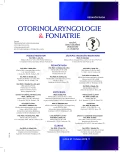Spontaneous Pneumomediastinum after Ingestion of Amphetamine
Authors:
O. Trčka; D. Slouka
Authors‘ workplace:
ORL klinika Lékařské fakulty Univerzity Karlovy v Plzni a Fakultní nemocnice Plzeň
Published in:
Otorinolaryngol Foniatr, 67, 2018, No. 1, pp. 28-31.
Category:
Case Reports
Overview
Introduction:
Pneumomediastinum is defined as the presence of free air in the mediastinum. The most common manifestations of this disease include pain of the neck, chest pain and dyspnea. We distinguish primary (spontaneous) and secondary pneumomediastinum. Primary (spontaneous) pneumomediastinum is caused by increase of intrathoracic pressure (e.g. coughing, vomiting, and sudden inhalation) with subsequent rupture of alveolar membrane and penetration of air into the fascial layers of mediastinum. It is a state with minimal complications and with good tendency of spontaneous recovery. We find, especially in foreign literature, numerous mentions of the connection between abuse of addictive substances (amphetamines, cocaine, marihuana, heroin) and the occurrence of primary pneumomediastinum (1,9,13-17). This condition has to be distinguished from secondary pneumomediastinum, which is caused by penetration of air into the mediastinum via trauma (external trauma, endoscopy of digestive tract, intubation, foreign bodies) or rupture of aerodigetive tract (sudden abdominal disorder, pulmonary emphysema). Secondary pneumomediastinum is only a symptom of pathology which is potentially fatal and needs causal treatment.
Case report:
A patient (22 years) under the influence of alcohol was examined in the early morning hours at an ENT emergency after experiencing several hours of neck pain with a feeling of light pressure on the chest. With the diagnosis of acute pharyngitis he was sent to home care. A few hours later, the patient returned to an ENT emergency after the condition had deteriorated and the “swelling of the throat” resumed once again. Clinical examination showed subcutaneous emphysema with crepitation. The patient was promptly admitted for further diagnosis. The performed CT scan confirmed extensive pneumomediastinum. By the detailed analysis of patient’s history, laboratory results and clinical examination, we excluded secondary pneumomediastinum. Toxicological analysis of urine confirmed hidden abuse of addictive substance- MDMA (3,4- methylendioxy-N-methy-amphetamine), so- called Extasy. The condition was summarised as pneumomediastinum caused by ingestion of addictive substance. A control CT scan after conservative treatment showed significant regression of the pneumomediastinum. The patient was sent to home care and to care of general practitioner on the fifth day of hospitalization.
Conclusion:
Primary pneumomediastinum is a condition, very rarely bringing patients to acute treatment. Due to the character of complaints (neck pain, dyspnea), ENT emergency can be the first place of contact, as is documented by our experience. Primary (spontaneous) pneumomediastinum is a self-limiting condition with minimal complications, in some cases connected with abuse of addictive substances. It is imperative to exclude secondary pneumomediastinum in order to prevent potentially fatal complications.
Keywords:
spontaneous pneumomediastinum, metamfetamine
Sources
1. Ahmed, J. M., Salam, M. Y., Oakley, G. D.: Chest pain in young girl. Postgrad Med. J., 74, 1998, s. 15-16.
2. Bolehovský, J.: Extáze. http://www.policie.cz/soubor/extaze-pdf.
3. Caraballo, V., Barish, R., Floccare, D.: Pneumomediastinum presenting as acute airway obstruction. J. Emerg. Med., 14, 1996, s. 159-162.
4. Amore, D. T., Dayan, P. S.: Medical causes of pneumomediastinum in children. Clin. Pediatr. (Phila), 40, 2001, (2, s. 87-91.
5. Gibikote, S., Sraz, A., Fink, A. M.: Pneumorrhachis secondary to traumatic pneumomediastinum in a child. Pediatr. Radiol., 36, 2006, s. 711-713.
6. Gowing, L. R., Henry-Edwards, S. M., Irvine, R. J. et al.: The health effects of ecstasy: A literature rewiev. Drug Alcohol Rev., 21, 2002, s. 53-63.
7. Hartus, R., Joseph, A.: Spontanous pneumomediastinum – „ecstasy“: hard pill to swallow. Aus. NZ J. Med., 30, 2000.
8. Lee, S. C., Lee, D. H., Kim, G. J.: Is primary spontaneous penumomediastinum a truly benign entity? Emergency Medicine Australasia, 26, 2014, s. 573-578.
9. Levine, A. J., Drew, S., Rees, G. M.: „Ecstasy“ induced pneumomediastinum. J. Royal Soc. Med., 86, 1993, s. 232-233.
10. Maunde, R. J., Pierson, D. J., Hudson, L. D.: Subcutaneous and mediastinal emphysema: Pathophysiology, diagnosis and management. Arch. Intern. Med., 144, 1984, s. 1447-1453.
11. Mazur, S., Hitchcock, T.: Spontaneous pneumomediastinum, pneumothorax and ecstasy abuse. Emergency Medicíně, 13, 2001, s. 121-123.
12. James, M., Miguel, M., Fancher, T.: Spontaneous pneumomediastinum. Journal of Hospital Medicíně, 2, 2007, 4.
13. Onwudik, M.: Ecstasy induced retropharyngeal emphysema. J. Accid. Emerg. Med., 13, 1996, s. 359-361.
14. Panacek, E., Winter, A., Sherman, B. et al: Spontaneous pneumomediastinum : clinical and natural history. Ann. Emerg. Med., 21, 1992, s. 1222-1227.
15. Pittman, J., Pounsford, J.: Spontaneous pneumomediastinum and ecstasy abuse. J. Accid. Emerg. Med., 14, 1997, s. 335-336.
16. Ruin, G. I., McCarth, G. M., Harries, D. K.: Spontaneous pneumomediastinum and ecstasy abuse. J. Accid. Emerg. Med., 16, 1999, s. 382.
17. Razvani, K., Kurbaan, A. S., Breto, D.: Ecstasy induced pneumomediastinum. Torax, 51, 1996 s. 960-961.
18. Riccio, J., Abbot, J.: A simple sore throat? Retropharyngeal emphysema secondary to free-basin cocaine. J. Emerg. Med., 1990; 8, s. 709-712.
19. Seman, M. E.: Barotrauma related to inhalation drug abuse. J. Emerg. Med., 1990, 8, s. 141-149.
Labels
Audiology Paediatric ENT ENT (Otorhinolaryngology)Article was published in
Otorhinolaryngology and Phoniatrics

2018 Issue 1
Most read in this issue
- Blindness as a Result Late Therapy of Retrobulbar Hematoma
- Acute Isolated Sphenoiditis in Children
- Balloon Eustachian Tuboplasty Treatment of Eustachian Tube Dysfunction
- Cavernous Sinus Thrombosis as Rare Complication of the Rhinosinusitis - Case Report and Survey of the World Literature
